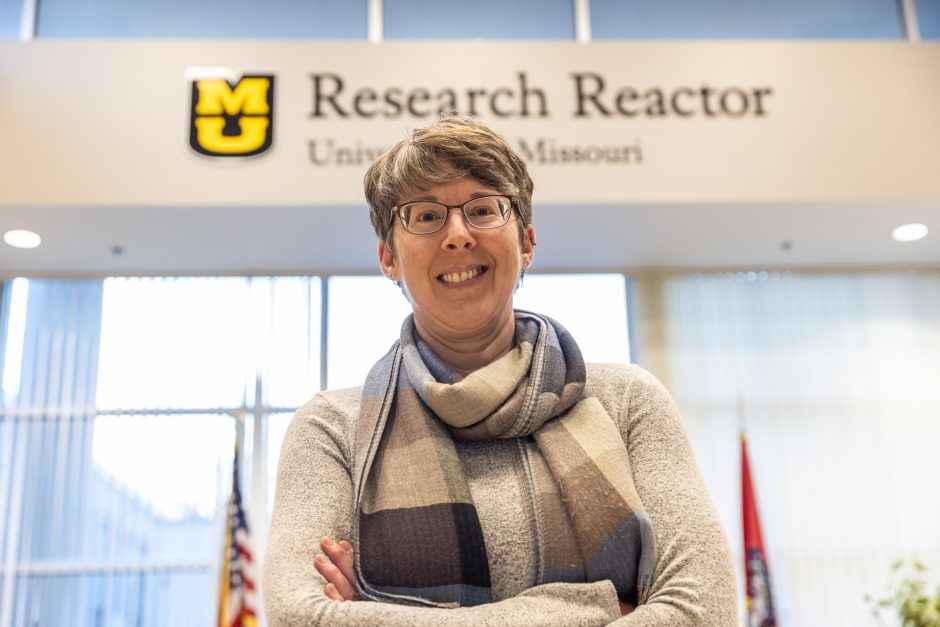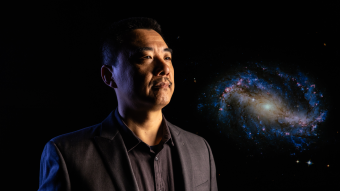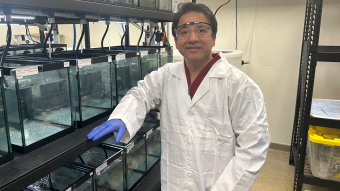By Eric Stann

July 22, 2025
Contact: Eric Stann, StannE@missouri.edu
Photo by Abbie Lankitus
A promising breakthrough in cancer treatment is taking shape at the University of Missouri Research Reactor (MURR), where scientists are developing a powerful radioisotope that could one day precisely target and destroy cancer cells.
A recent study led by Heather Hennkens, an associate professor at Mizzou’s Department of Chemistry and a researcher at MURR, investigated how to produce, purify and formulate Terbium-161 for radiopharmaceutical use.
Through this work, Hennkens’ lab is optimizing the radioisotope so it can be effectively attached to a targeting molecule and sent as the therapeutic “payload” to destroy tumor cells.
Packing a one-two punch
Terbium-161 is in the same chemical family as Lutetium-177, a widely used radioisotope produced at MURR for neuroendocrine tumor and prostate cancer treatments.
Both are lanthanides, meaning they have similar chemical properties. Because of this, a drug made to work with one should also work with the other — making it almost “plug and play,” Hennkens said.
The hallmark of both treatments is their high-energy electrons — beta particles — which are effective against large tumors.
“This allows for the integration of terbium into existing treatments, potentially adding extra therapeutic effectiveness without requiring entirely new drug development,” Hennkens said.
What sets terbium apart from its chemical cousin is its ability to deliver a “one-two punch” to the cancer cells with its additional low-energy electrons — Auger and conversion electrons.
“These low-energy electrons travel very short distances within the tumor while creating significant damage to the cancer cells along the way,” Hennkens said. “This provides us with the ability to treat more dispersed or microscopic forms of disease, such as smaller clusters of metastasized cells and potentially even single circulating cells.”
Because both isotopes are damaging in nature, Hennkens said it’s important to pair them with the right targeting molecule — one that can deliver the radioactive material directly to the tumor cells while avoiding healthy tissues.
A domestic supply chain
MURR is the sole U.S. supplier of four medical isotopes, and Hennkens hopes Terbium-161 can be added to that list. As she and other scientists at MURR refine the process, they are laying the groundwork for its domestic production — a step that could reduce reliance on foreign sources and strengthen the U.S. medical isotope supply chain.
She and her team reported their findings in the study, “Production and purification of research scale 161Tb using cation-exchange semi-preparative HPLC for radiopharmaceutical applications,” published in the journal Radiochimica Acta.
Co-authors are Patrick Bokolo, Madhushan Serasinghe, Marina Kuchuk, Jim Guthrie, Mary Embree, Stacy Wilder, Carolyn J. Anderson and Silvia S. Jurisson at Mizzou; Dmitri G. Medvedev and Cathy S. Cutler at Brookhaven National Laboratory; and D. Scott Wilbur and Yawen Li at University of Washington.



